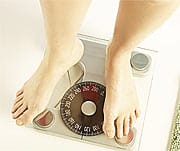Life Extension Magazine®
Abdominal obesity represents one of the greatest health and cosmetic challenges in modern society. Abdominal fat is not just aesthetically unpleasing. It also represents a serious health hazard. Excess abdominal fat that grows around internal belly organs (also known as visceral fat) is linked with a host of undesirable conditions,1-7 including increased inflammation, and elevated risks of type 2 diabetes, high blood pressure, atherosclerosis, and cardiovascular disease. While abdominal obesity is commonplace in America,8 even healthy-weight men and women often struggle with a different kind of fat—the type that sits just under the skin—known as subcutaneous abdominal fat. This kind of fat can lead to sagging belly skin or a persistent belly pouch, which lingers long after other excess pounds have been laboriously starved and exercised away. Fortunately, scientists are providing tools that can help motivated men and women reduce the visual appearance of abdominal fat and regain skin tone. These tools include nutrients, hormones, and drugs that work from the inside-out by targeting visceral abdominal fat to promote weight loss. Added to this arsenal is a new topical formula that targets stubborn subcutaneous belly fat by working from the outside-in, mimicking the kind of benefits it would normally take strenuous exercise to achieve. By providing a comprehensive weight-loss and body-contouring strategy, these complementary strategies represent an integrated approach for reducing both dangerous visceral fat and problematic subcutaneous fat. German researchers conducted a decade-long multinational study involving nearly 360,000 patients. They found that even when the body mass index (BMI) is within normal range, excess abdominal fat is significantly associated with an increased risk of dying.9 These scientists were not just talking about the abdominally obese. It turns out that any excess amount of belly fat increases risks of age-related diseases. Suffice it to say that the dangers of abdominal obesity are well documented, as are the benefits of weight loss.1-7 Subcutaneous Fat: Stubborn Enemy of the Flat Belly
After a certain age, even avid dieters and dedicated exercise buffs may be forced to face facts: that last bit of belly fat simply refuses to budge, despite vain attempts at “spot” exercising. Or perhaps you have found, to your dismay, that the perfection of your hard-won hard body is marred by the specter of unsightly inconsistencies in skin tone and drape, where skin has been stretched beyond its limits. Visible emblems, they testify to years of yo-yo dieting, or bear witness to the contour-altering effects of a pregnancy long past. With advancing age, skin gradually thins, while underlying support structures—collagen and elastin—lose their former ability to hold skin taut. As a result, even the most dedicated exercise enthusiast may suffer from sagging belly skin, or a persistent belly pouch. And that’s not to say that men are immune to this frustrating situation.8 With advancing age, it becomes increasingly difficult for even the most disciplined gentleman to banish bulging belly fat, despite strict adherence to a dedicated regimen of targeted exercises and carefully controlled diet. That’s because the fat in question is deposited not deep in the gut, but superficially, just beneath the skin. Differences Between Visceral and Subcutaneous FatStudies have repeatedly demonstrated that subcutaneous fat is inherently different than visceral fat, and it is especially resistant to elimination through “burning” (thermogenesis or lipolysis).10,11 The fat cells (adipocytes) comprising visceral and subcutaneous fat derive from different sources, and in essence, “behave” differently. Visceral fat responds well to dieting and exercise, for instance, while subcutaneous fat does not. Of course, when you are confronted with your reflection in the mirror, fat is fat, and that’s that. But on the cellular level, there are distinct differences between visceral and subcutaneous fat.11,12
One difference is rooted in physiology. Visceral fat cells are predominantly studded with structures known as beta adrenoreceptors,10 which, when triggered by certain signals (prompted by reduced calorie intake, for example), stimulate the cells to undergo lipolysis. During lipolysis, the lipids (fats in the form of triglycerides), which make up the bulk of the fat cell, are converted to free fatty acids, which are then oxidized as “fuel” to decrease fat stores. In essence, lipolysis and fatty acid oxidation comprise the process commonly referred to as “fat burning.” As these lipids are metabolized to release energy, fat stores are depleted, and adipose cells shrink. By comparison, rather than possessing numerous beta adrenoreceptors, which are responsive to dieting, subcutaneous fat cells are primarily studded with alpha-2 adrenoreceptors. Consequently, they are far more resistant to shrinkage through ordinary dieting-induced lipolysis. Concerns about one’s physical appearance are legitimate and understandable. For better or worse, outward appearance affects everything from self-esteem to the ability to compete in an increasingly competitive job market. But it is notoriously difficult to eliminate excess weight—and keep if off—once established.13 So men and women who have managed to avoid this trap—or who have overcome it through considerable sacrifice and determination—surely deserve to reap the full benefits of their labors. A chief benefit of weight control is the psychological reward that comes not only from being fit and healthy, but from looking and feeling good. And part of looking good is sporting a fully beach-ready flat belly. The Leptin ConnectionThe reasons to banish one’s belly bulge are more than merely cosmetic. Emerging research suggests that while deep visceral fat contributes to many of the worst health effects associated with obesity, it is subcutaneous fat that is a stronger determinant than visceral fat of circulating levels of leptin,14 the key hunger-regulating hormone. Leptin influences how much one eats, and thus, how likely one is to lose weight and keep it off.15,16
When originally discovered, leptin was regarded as a potential new weapon against obesity. Leptin was shown to help regulate hunger by triggering a cascade of chemicals that interact with a circuit in the brain involved in satiety. Higher levels of leptin circulating in the bloodstream were assumed to correspond with a sense of fullness and were believed to protect an individual from overeating. Injecting obese subjects with the hormone was viewed as a potential breakthrough treatment. But those early hopes were quickly dashed. Obese people already have high levels of leptin, it turns out.16-19 The problem, it was soon discovered, is that obese people develop “leptin resistance,” a condition akin to insulin resistance, in which the cells no longer respond normally to a hormone messenger. This is due, in part, to the fact that in obese people, leptin interacts with inflammation-related proteins, such as C-reactive protein. This interaction blocks leptin’s ability to cross the blood-brain barrier, preventing leptin from transmitting its satiety signals.20 Leptin resistance is now believed to be both a cause and a consequence of obesity.21 “Once leptin resistance takes hold, it aggravates diet-induced obesity and the leptin resistance and obesity compound one another, promoting a vicious cycle of escalating weight gain,” wrote researchers recently.16 And according to a 2002 study, “accumulation of intra-abdominal [visceral] fat correlates with insulin resistance, whereas subcutaneous fat deposition correlates with circulating leptin levels.”22 Accordingly, it may be helpful to reduce subcutaneous belly fat in addition to visceral belly fat in order to prevent leptin resistance from developing. Fortunately, while cutting-edge research has led to therapies to reduce visceral fat, a new topical approach promises to complement these strategies by helping to fight unsightly subcutaneous belly fat.
From the Outside-In: A Topical Approach to Belly Slimming and FirmingEven highly motivated people who follow a sensible, nutrient-dense (as opposed to calorie-dense) diet, and a program of daily exercise, may find it exceptionally difficult to lose subcutaneous belly fat. That is why it makes sense to tame this intractable store of fat from the outside-in, using specialized nutrients that have both slimming and toning components. As highlighted below, delivering targeted ingredients directly into the skin has one key objective: to initiate lipolysis using a strategy that does not depend on beta-adrenoreceptor activation, since subcutaneous fat cells have a lower concentration of beta adrenoreceptors (which stimulate lipolysis) and a higher concentration of alpha adrenoreceptors (which inhibit lipolysis). This can be achieved with active ingredients that:
Increasing cAMP while inhibiting Lipoprotein LipaseXantalgosil C® is designed to promote subcutaneous lipolysis. It contains a synergistic combination of organic silicon and a xanthic base (similar to the caffeine and theophylline found in green tea) that activates lipolysis by increasing cAMP and prevents further fat storage by inhibiting lipoprotein lipase. Xantalgosil C® also improves microcirculation, reduces inflammation, and yields firmer skin.24 In a study conducted on 25 non-obese patients aged 22-54 years old, Xantalgosil C® reportedly improved skin appearance within two months of use. In addition, more than half of the treated subjects lost nearly two inches from around the waist.24 Reducing Degradation of cAMPWhile stimulating beta adrenoreceptors increases cAMP concentrations in fat cells, this lipolytic effect can also be achieved by preventing the degradation of cAMP in the first place by inhibiting an enzyme called phosphodiesterase (which catalyzes the conversion of cAMP to AMP). Caffeine is an important phosphodiesterase inhibitor. Studies have shown that ordinary caffeine can encourage fat loss by stimulating resting energy expenditure, lipid mobilization, and fat oxidation,23 while also promoting the reduction of cellulite.2a5-27 A study in which a caffeine-based cream was topically applied all over the body showed that it significantly reduced the thickness of subcutaneous fat over a two-month period.28 Furthermore, the penetration of caffeine into the skin can be enhanced by encapsulating caffeine molecules in specialized intradermal carriers called QuSomes®. This advanced delivery system transports active ingredients deep into the skin’s dermal layers (Continued on Page 2). | ||||||
Anti-Differentiation EffectAdipose tissue is the major energy reserve in humans, involved in the storage and mobilization of fat. Adipocytes are derived from precursor cells called pre-adipocytes. As pre-adipocytes mature, they expand and accumulate triglycerides. Weight gain, overweight, or obesity results from an excess of adipose tissue caused by greater numbers of adipocytes (hyperplasia) and increased fat storage (hypertrophy) within them. Sphacelaria scoparia is an extract of the brown alga called sea broom, which reportedly reduces fat by inhibiting differentiation of pre-adipocytes into mature fat cells by decreasing the expression of several key transcription factors involved in this process.29 Sphacelaria scoparia works in a complementary manner with Xantalgosil C® and caffeine to reduce the size of existing fat cells, while reducing the number of new fat cells. This strategy mimics the kind of benefits that would ordinarily require strenuous exercise to achieve. Sphacelaria scoparia also increases the synthesis of types I and IV collagen, which are crucial dermal components for maintaining skin integrity and improving skin firmness and tone.29 Skin-Toning IngredientsChlorella: This extract is derived from the green alga Chlorella vulgaris and is rich in amino acids and proteins that work to promote healthy skin tone by encouraging the synthesis of natural proteins, such as elastin, laminin, and collagen.30 These proteins help anchor the outer epidermal skin layer to the deeper dermal layers, at the dermo-epidermal junction.30 By also protecting collagen from matrix-degrading enzymes in the skin, Chlorella enhances structure and support, yielding firmer skin with better, more youthful tone.30 Regu®-Stretch: This includes extracts of the herb Marrubium vulgare, the pro-B-vitamin panthenol, and a synthetic peptide (protein fragment). Regu®-Stretch is an active complex especially intended for reducing the appearance and occurrence of stretch marks.31 It also stimulates collagen production and improves skin elasticity, moisture, and suppleness.31 More Than Skin Deep: The QuSomes® Delivery System
Job one for human skin is to serve as a barrier, protecting the interior of the body from the external environment. For the most part, skin is remarkably effective at its job. As a result, it has traditionally been extraordinarily difficult to formulate topically applied cosmeceuticals capable of penetrating beyond the epidermis—the outer layer of inert skin cells—to deliver active ingredients to the underlying layers of living skin, where they can actually do some good. That is why scientists developed the QuSomes® delivery system. Designed to harness skin cells’ natural affinity for lipids, the QuSomes® intradermal system essentially encapsulates active ingredients in microscopic designer spheres, similar to liposomes, which are capable of penetrating deep within dermal tissue.32 Composed of natural compounds called phospholipids, these nanospheres do their job safely and effectively. Upon reaching their intended targets, these tiny spheres are welcomed into living fat cells which can include subcutaneous adipocytes. Rather than relying on interactions with receptors on the cells’ exterior, they now have the ability to enter directly into the interior of the cells. After entering the cells, they release their “cargo” of lipolysis-enhancing (fat breakdown) ingredients. They may also be harnessed to deliver agents capable of promoting collagen and elastin proliferation, to encourage the growth of firmer, more elastic skin. ConclusionThe human body has evolved complex mechanisms to ensure survival through the storage of excess calories as fat. In Paleolithic times, this made sense; opportunities for feasting were ordinarily tempered by unpredictable times of famine. But the modern world is drastically different. We no longer face the constant threat of starvation. On the contrary, we are surrounded, 24/7 by constant access to inexpensive calorie-dense foods, while we are required to expend far less energy to obtain them. This relatively rapid change has exceeded the body’s ability to balance the intake and output of energy, resulting in ever-increasing pressure to store excess calories as fat. This situation threatens people’s physical, emotional, and financial viability. Fortunately, the development of complementary nutraceuticals, natural hormones, and in some cases certain drugs can resolve this problem internally and now externally with targeted topical ingredients. In conjunction with a sensible diet and exercise program, these topically applied compounds offer much-needed assistance in the struggle to reduce abdominal fat mass and maintain a pleasing contour. A new comprehensive program to reduce visceral abdominal fat will be unveiled in the next issue of Life Extension magazine. In the meantime, a novel topical preparation has been developed to help reduce the appearance of subcutaneous fat while firming loose abdominal skin. If you have any questions on the scientific content of this article, please call a Life Extension Health Advisor at 1-800-226-2370. | ||
| References | ||
| 1. Int J Obes (Lond). 2009 Feb;33(2):239-48. 2. Am J Med. 2009 Jan;122(1 Suppl):S26-37. 3. Int J Obes (Lond). 2008 Dec;32(Suppl 7):S83-92. 4. Br J Nutr. 2004 Sep;92(3):347-55. 5. Proc Nutr Soc. 2005 Feb;64(1):31-8. 6. JPEN J Parenter Enteral Nutr. 2008 Nov-Dec;32(6):645-7. 7. Obes Surg. 2004 May;14(5):589-600. 8. Diabetes Care. 2009 Mar;32(3):481-5. 9. N Engl J Med. 2008 Nov 13;359(20):2105-20. 10. Horm Metab Res. 2009 Feb 9. 11. Ann Med. 1995 Aug;27(4):435-8. 12. J Proteome Res. 2009 Feb 9. 13. Obes Surg. 2007 Oct;17(10):1389-98. 14. Int J Obes Relat Metab Disord. 2000 Sep;24(9):1139-44. 15. Am J Clin Nutr. 2009 Mar;89(3):991S-997S. 16. Am J Physiol Regul Integr Comp Physiol. 2009 Mar;296(3):R493-500. 17. Exp Clin Endocrinol Diabetes. 1996;104(4):293-300. 18. Am J Clin Nutr. 2009 Jan 28. 19. N Engl J Med. 1996 Feb 1;334(5):292-5. 20. J Am Coll Cardiol. 2008 Oct 7;52(15):1201-10. 21. Diabetologia. 2005 Jun;48(6):1075-83. 22. Diabetes. 2002 Apr;51(4):1005-15. 23. Am J Clin Nutr. 2004;79:40-6. 24. Exsymol SAM. Data on file. 25. J Cosmet Dermatol. 2007 Jun;6(2):102-7. 26. J Cosmet Dermatol. 2008 Mar;7(1):23-9. 27. J Dtsch Dermatol Ges. 2006 Oct;4(10):861-70. 28. Dermatol Surg. 1999;25(6):455-62. 29. Codif Recherche et Nature. Data on file. 30. Barnet Products Corporation. Data on file. 31. DSM Nutritional Products Ltd. Branch PENTAPHARM. Data on file. 32. BioZone Laboratories Inc. Data on file. |






